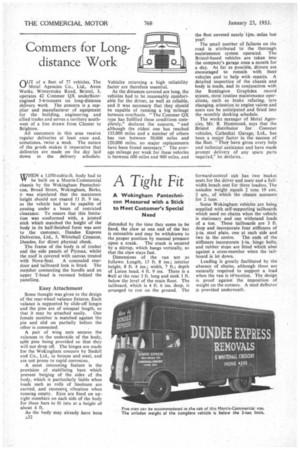A Tight Fit
Page 34

If you've noticed an error in this article please click here to report it so we can fix it.
A Wokingham Pantechnicon Measured with a Stick to Meet Customer's Special Need
WHEN a 1,050-cubic-ft. body had to be built on a Morris-Commercial chassis by the Wokingham Pantechnicon, Broad Street, Wokingham, Berks, it was stipulated that the maximum height should not exseed 11 ft. 9 ins., as the vehicle had to be capable of passing under a beam of restricted clearance. To ensure that this limitation was conformed with, a jointed stick which matched the height of the body in its half-finished form was sent to the customer, Dundee Express Deliveries, Ltd., 5, Whitehall Crescent, Dundee, for direct physical check.
The frame of the body is of timber and the side panels of Plymax, whilst the roof is covered with canvas treated with Nova-Seal. A concealed reardoor and tailboard lock is fitted. The member connecting the handle and an upper T-head is recessed behind the panelling.
Easy Attachment
Some thought was given to the design of the rear-wheel valance fixtures. Each valance is supported by slide-off hinges and the pins are of unequal length, so that it may be attached easily. One female member is matched against the pin and slid on partially before the other is connected.
A pair of wing nuts secures the valances to the underside of the body, split pins being provided so that they will not drop off. The hinges are made for the Wokingham concern by Stedall and Co., Ltd., in bronze and steel, and are not prone to rapid corrosion.
A most interesting feature is the provision of stabilizing bars which prevent bulging of the sides of the body, which is particularly liable when loads such as rolls of linoleum are carried, and excessive) vibration when running empty. Eyes are fixed on upright members on each side of the body for these bars to fit into at a height of about 4 ft.
As the body may already have been A32 distended by the time they come to be fixed, the claw at one end of the bar is extensible and may be withdrawn to the proper position by manual pressure upon a crank. The crank is secured by a stirrup, which hangs vertically, so that the claw stays fast.
Dimensions of the van are as follows: Length, 15 ft. 8 ins.; interior height, 8 ft. 4 ins.; width, 7 ft.; depth of Luton head, 4 ft. 9 ins. There is a Aral at the rear 3 ft, long and sunk 1 ft. below the level of the main floor. The tailboard, which is 4 ft. 6 ins, deep, is arranged to rest on the ground. The forward-control cab has two bucket seats for the driver and mate and a fullwidth bench seat for three loaders. The unladen weight equals 2 tons 19 cwt. 2 qrs., of which the chassis accounts for 2 tons..
Some Wokingham vehicles are being supplied with self-supporting tailboards which need no chains when the vehicle is stationary and can withstand loads of a ton. These tailboards are 3 ft. deep and incorporate four stiffeners of fin, steel plate, one at each side and two in the centre. The ends of the stiffeners incorporate s-in. hinge bolts, and rubber stops are fitted which abut against a cross-member when the tailboard is let down.
Loading is greatly facilitated by the absence of chains, although these are naturally required to support a load when the van is irrmotion. The design is proof against the imposition of weight on the corners. A mud deflector is provided underneath.
























































































































































